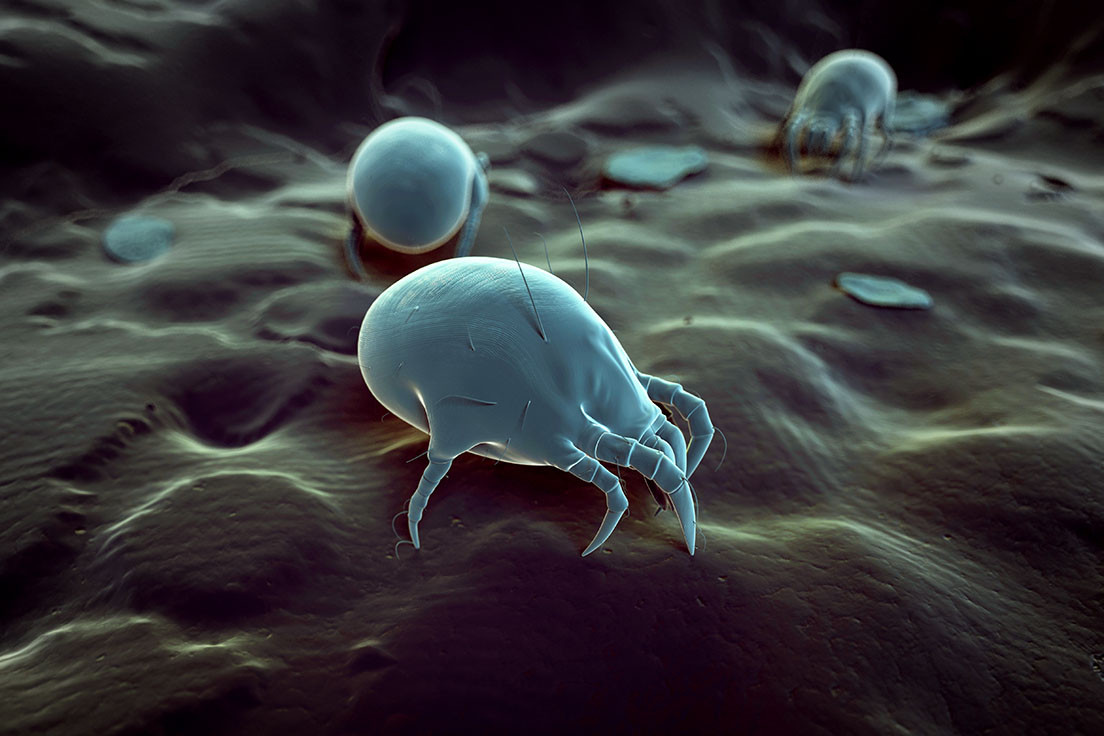
Dust Mites—The Silent Enemy Causing Nasal Allergies and Asthma

Highlights:
- 70-80 percent of allergy patients in Thailand are affected by “dust mite” allergies, which have a significant impact on their quality of life.
- Immunotherapy treatments can reduce the symptoms of dust mite allergies, minimize the use of medications, prevent recurrence and exacerbation, and inhibit the progression of allergic rhinitis to asthma.
- More than 80% of children suffering from asthma showed sensitivities to environmental allergens, particular those found in the home, such as dust mites, animal furs, or mold.
“Dust mites” are one of the most common causes of respiratory allergies in Thailand and are a major risk factor in the exacerbation of asthma symptoms in allergic asthmatic patients. In cases of prolonged exposure to dust mites and without proper treatment, it has been found that more than 80% of children suffering from asthma showed sensitivities to environmental allergens, especially those found in the home, such as dust mites, animal furs, and mold.
It has also been found that 70-80 percent of allergy patients in Thailand are affected by dust mites. The most common respiratory allergy is allergic rhinitis (hay fever), which is found in 23-30 percent of patients and carries with it symptoms such as runny nose, sneezing, itchy and/or stuffy nose, as well as eye-related symptoms such as itchy, red, or swollen eyes, and dark circles under the eyes. Additional symptoms include pressure, blockage or popping in the ear, as well as pain in the bridge of the nose and other areas of the face. Allergic asthma is found in 10-15 percent of allergy patients, with symptoms such as shortness of breath, difficulty breathing, wheezing, and chronic coughing, especially at night. When patients in this group catch a cold, they tend to cough more and for longer than usual.
Understanding “Dust Mites”
There are two main species of dust mites which are found in 80% of homes: Dermatophagoides pteronyssinus and Dermatophagoides farinae. These dust mites are tiny and cannot be seen with the naked eye but can only be viewed using a camera with a magnification of at least 25 times. Experiments have revealed that dust mites show optimal growth in locations with a temperature of 45 degrees Celsius and 75% relative humidity. In these environments, skin flakes from humans and animals are shed more quickly and are subsequently fed on by dust mites. Thus, the more food available to them, the more the dust mites flourish and multiply.
Both the body parts and the waste droppings of dust mites are allergens for many people. Areas of the home in which greater numbers of dust mites are usually found include beds and mattresses, pillows, sofas, wardrobes, and anywhere that dust collects.
Dust Mite Allergy Treatments
Current allergy and asthma treatment guidelines state that allergen avoidance by one method or another, especially when it comes to dust mites, may not be as effective as originally thought and that a combination of methods or treatments may be required. Such methods include exercise and the use of medications, including oral or nasal sprays or allergen immunotherapy (also known as allergy shots). In addition, risk factor changes can help, such as losing weight, stopping smoking, and avoiding car exhaust fumes or incense smoke, in order to reduce the stimulation or exacerbation of allergic symptoms as a result of the patient’s everyday environment.
Prolonged usage of nasal or oral decongestant sprays to control nasal allergies and asthma may be a cause of concern for some. However, studies and other information on these medications have not revealed any adverse reactions or significant side effects.
Currently, the most targeted type of treatment is allergen-specific immunotherapy for dust mites, which can be administered via injections (subcutaneous immunotherapy: SCIT) or as drops or tablets kept under the tongue and then swallowed (sublingual immunotherapy: SLIT). The latter can easily be taken by patients themselves at home.
Things to consider before taking sublingual immunotherapy
- Have you ever had an allergic reaction to this drug or any of its ingredients?
- Have you had any severe asthma attacks in the past 3 months?
- Are you suffering from any immune system disorders or from cancer?
- Are you currently taking any immunosuppressant drugs?
- Have you recently had a tooth extraction or oral surgery, or do you have any sores or infections in your mouth?
If any of the following apply, you should inform your doctor for your own safety before taking the drug:
- Are you taking medication to treat depression or Parkinson’s disease?
- Are you allergic to fish or any fish-based foods?
- Are you taking any other herbal medicines or supplements?
- Are you currently pregnant or breastfeeding?
- Have you ever had a severe allergic reaction after receiving a dust mite allergy injection?
Symptoms for which you should stop taking the drug and see a doctor immediately:
- Swelling of the face, eyelids, or lips
- Hives
- Dizziness, fainting, chest tightness, or trouble breathing
- Rash, blisters, skin flaking or peeling, or fever
- Severe asthma attacks or abnormal exacerbation
Related
articles
